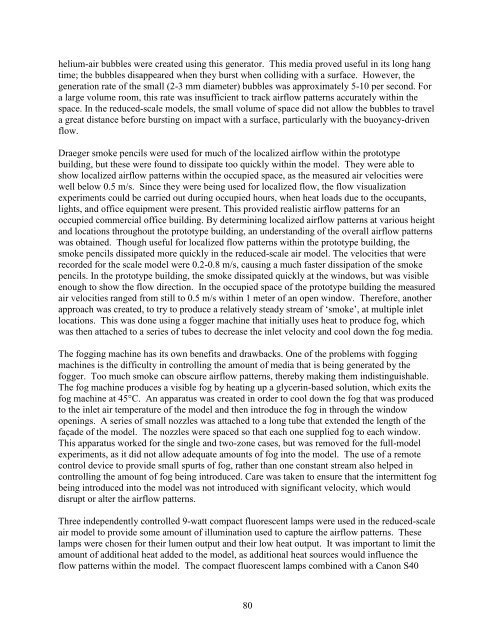Methodology for the Evaluation of Natural Ventilation in ... - Cham
Methodology for the Evaluation of Natural Ventilation in ... - Cham
Methodology for the Evaluation of Natural Ventilation in ... - Cham
Create successful ePaper yourself
Turn your PDF publications into a flip-book with our unique Google optimized e-Paper software.
helium-air bubbles were created us<strong>in</strong>g this generator. This media proved useful <strong>in</strong> its long hangtime; <strong>the</strong> bubbles disappeared when <strong>the</strong>y burst when collid<strong>in</strong>g with a surface. However, <strong>the</strong>generation rate <strong>of</strong> <strong>the</strong> small (2-3 mm diameter) bubbles was approximately 5-10 per second. Fora large volume room, this rate was <strong>in</strong>sufficient to track airflow patterns accurately with<strong>in</strong> <strong>the</strong>space. In <strong>the</strong> reduced-scale models, <strong>the</strong> small volume <strong>of</strong> space did not allow <strong>the</strong> bubbles to travela great distance be<strong>for</strong>e burst<strong>in</strong>g on impact with a surface, particularly with <strong>the</strong> buoyancy-drivenflow.Draeger smoke pencils were used <strong>for</strong> much <strong>of</strong> <strong>the</strong> localized airflow with<strong>in</strong> <strong>the</strong> prototypebuild<strong>in</strong>g, but <strong>the</strong>se were found to dissipate too quickly with<strong>in</strong> <strong>the</strong> model. They were able toshow localized airflow patterns with<strong>in</strong> <strong>the</strong> occupied space, as <strong>the</strong> measured air velocities werewell below 0.5 m/s. S<strong>in</strong>ce <strong>the</strong>y were be<strong>in</strong>g used <strong>for</strong> localized flow, <strong>the</strong> flow visualizationexperiments could be carried out dur<strong>in</strong>g occupied hours, when heat loads due to <strong>the</strong> occupants,lights, and <strong>of</strong>fice equipment were present. This provided realistic airflow patterns <strong>for</strong> anoccupied commercial <strong>of</strong>fice build<strong>in</strong>g. By determ<strong>in</strong><strong>in</strong>g localized airflow patterns at various heightand locations throughout <strong>the</strong> prototype build<strong>in</strong>g, an understand<strong>in</strong>g <strong>of</strong> <strong>the</strong> overall airflow patternswas obta<strong>in</strong>ed. Though useful <strong>for</strong> localized flow patterns with<strong>in</strong> <strong>the</strong> prototype build<strong>in</strong>g, <strong>the</strong>smoke pencils dissipated more quickly <strong>in</strong> <strong>the</strong> reduced-scale air model. The velocities that wererecorded <strong>for</strong> <strong>the</strong> scale model were 0.2-0.8 m/s, caus<strong>in</strong>g a much faster dissipation <strong>of</strong> <strong>the</strong> smokepencils. In <strong>the</strong> prototype build<strong>in</strong>g, <strong>the</strong> smoke dissipated quickly at <strong>the</strong> w<strong>in</strong>dows, but was visibleenough to show <strong>the</strong> flow direction. In <strong>the</strong> occupied space <strong>of</strong> <strong>the</strong> prototype build<strong>in</strong>g <strong>the</strong> measuredair velocities ranged from still to 0.5 m/s with<strong>in</strong> 1 meter <strong>of</strong> an open w<strong>in</strong>dow. There<strong>for</strong>e, ano<strong>the</strong>rapproach was created, to try to produce a relatively steady stream <strong>of</strong> ‗smoke‘, at multiple <strong>in</strong>letlocations. This was done us<strong>in</strong>g a fogger mach<strong>in</strong>e that <strong>in</strong>itially uses heat to produce fog, whichwas <strong>the</strong>n attached to a series <strong>of</strong> tubes to decrease <strong>the</strong> <strong>in</strong>let velocity and cool down <strong>the</strong> fog media.The fogg<strong>in</strong>g mach<strong>in</strong>e has its own benefits and drawbacks. One <strong>of</strong> <strong>the</strong> problems with fogg<strong>in</strong>gmach<strong>in</strong>es is <strong>the</strong> difficulty <strong>in</strong> controll<strong>in</strong>g <strong>the</strong> amount <strong>of</strong> media that is be<strong>in</strong>g generated by <strong>the</strong>fogger. Too much smoke can obscure airflow patterns, <strong>the</strong>reby mak<strong>in</strong>g <strong>the</strong>m <strong>in</strong>dist<strong>in</strong>guishable.The fog mach<strong>in</strong>e produces a visible fog by heat<strong>in</strong>g up a glycer<strong>in</strong>-based solution, which exits <strong>the</strong>fog mach<strong>in</strong>e at 45°C. An apparatus was created <strong>in</strong> order to cool down <strong>the</strong> fog that was producedto <strong>the</strong> <strong>in</strong>let air temperature <strong>of</strong> <strong>the</strong> model and <strong>the</strong>n <strong>in</strong>troduce <strong>the</strong> fog <strong>in</strong> through <strong>the</strong> w<strong>in</strong>dowopen<strong>in</strong>gs. A series <strong>of</strong> small nozzles was attached to a long tube that extended <strong>the</strong> length <strong>of</strong> <strong>the</strong>façade <strong>of</strong> <strong>the</strong> model. The nozzles were spaced so that each one supplied fog to each w<strong>in</strong>dow.This apparatus worked <strong>for</strong> <strong>the</strong> s<strong>in</strong>gle and two-zone cases, but was removed <strong>for</strong> <strong>the</strong> full-modelexperiments, as it did not allow adequate amounts <strong>of</strong> fog <strong>in</strong>to <strong>the</strong> model. The use <strong>of</strong> a remotecontrol device to provide small spurts <strong>of</strong> fog, ra<strong>the</strong>r than one constant stream also helped <strong>in</strong>controll<strong>in</strong>g <strong>the</strong> amount <strong>of</strong> fog be<strong>in</strong>g <strong>in</strong>troduced. Care was taken to ensure that <strong>the</strong> <strong>in</strong>termittent fogbe<strong>in</strong>g <strong>in</strong>troduced <strong>in</strong>to <strong>the</strong> model was not <strong>in</strong>troduced with significant velocity, which woulddisrupt or alter <strong>the</strong> airflow patterns.Three <strong>in</strong>dependently controlled 9-watt compact fluorescent lamps were used <strong>in</strong> <strong>the</strong> reduced-scaleair model to provide some amount <strong>of</strong> illum<strong>in</strong>ation used to capture <strong>the</strong> airflow patterns. Theselamps were chosen <strong>for</strong> <strong>the</strong>ir lumen output and <strong>the</strong>ir low heat output. It was important to limit <strong>the</strong>amount <strong>of</strong> additional heat added to <strong>the</strong> model, as additional heat sources would <strong>in</strong>fluence <strong>the</strong>flow patterns with<strong>in</strong> <strong>the</strong> model. The compact fluorescent lamps comb<strong>in</strong>ed with a Canon S4080
















